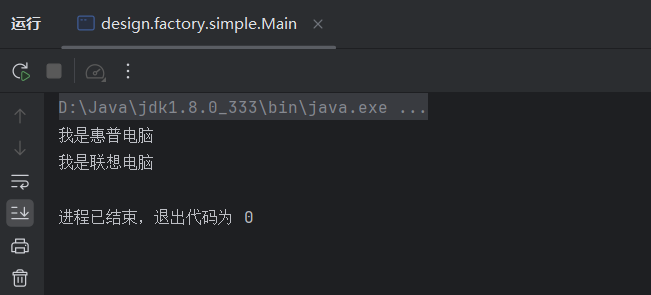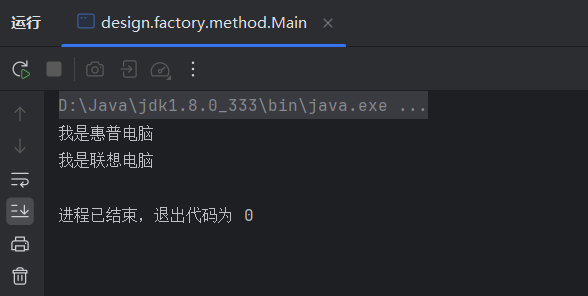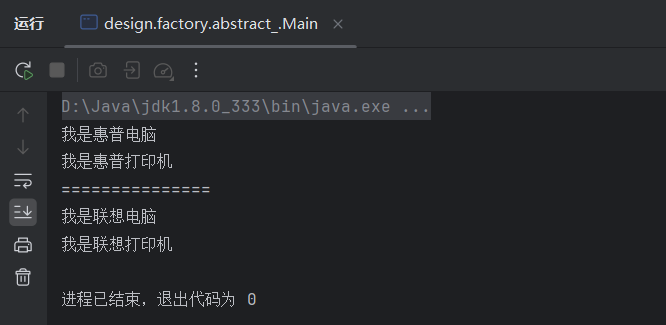1.简介
工厂模式是一种创建型设计模式,通过提供一个接口或抽象类来创建对象,而不是直接实例化对象。工厂模式的主要思想是将对象的创建与使用分离,使得创建对象的过程更加灵活和可扩展。
工厂模式主要包括以下角色:
- 抽象工厂(Abstract Factory):定义了一个创建产品对象的接口,可以包含多个方法来创建不同类型的产品。
- 具体工厂(Concrete Factory):实现抽象工厂接口,负责实例化具体的产品对象。
- 抽象产品(Abstract Product):定义了产品的接口或抽象类,是工厂方法和抽象工厂模式中的基础。
- 具体产品(Concrete Product):实现抽象产品接口,具体定义产品的功能和行为。
2.简单工厂模式
简单工厂模式(Simple Factory Pattern):由一个工厂类根据传入的参数决定创建哪一种产品类的实例。它通常包含一个静态方法,这个方法根据参数创建相应的对象。
定义一个简单的例子:电脑有很多品牌,如惠普电脑、联想电脑,如果需要创建这两个对象时,主动new出来,使用了简单工厂模式后,可以把创建的动作交给工厂类,只需要指定参数即可获取对应的对象。
实现方法
- 编写产品类
首先创建一个Computer接口,不同的产品实现这一接口
java
// 定义抽象产品接口
public interface Computer {
void compute();
}
// 定义具体产品,实现该接口
public class HPComputer implements Computer{
@Override
public void compute() {
System.out.println("我是惠普电脑");
}
}
public class LenovoComputer implements Computer{
@Override
public void compute() {
System.out.println("我是联想电脑");
}
}- 编写工厂类
简单工厂模式不存在抽象工厂,只需编写一个工厂类即可。
java
// 根据传入的参数创建对应产品
public class SimpleFactory {
public static Computer createProduct(String type) {
if (type.equals("HP")) {
return new HPComputer();
} else if (type.equals("Lenovo")) {
return new LenovoComputer();
} else {
throw new IllegalArgumentException("该类型无法被生产");
}
}
}- 测试类使用工厂创建产品
java
public class Main {
public static void main(String[] args) {
// 创建HP电脑
Computer hp = SimpleFactory.createProduct("HP");
// 创建Lenovo电脑
Computer lenovo = SimpleFactory.createProduct("Lenovo");
hp.compute();
lenovo.compute();
}
}输出结果如下:

小结
简单工厂模式虽然实现比较简单,但是工厂类的职责过重,增加新的产品类型需要修改工厂类,违背了开闭原则。
开闭原则: 软件实体(类、模块、函数等)应该对扩展开放,对修改关闭。
对扩展开放(Open for extension):软件实体应该允许在不改变其现有代码的情况下,通过增加新功能来对其进行扩展。也就是说,当软件的需求发生变化时,我们应该能够通过添加新代码来满足这些需求,而不需要修改已有的代码。
对修改关闭(Closed for modification):一旦软件实体被开发完成并投入使用,其源代码就不应该再被修改。这可以防止对现有功能的破坏,减少引入新的错误的风险,并使软件更加稳定和可维护。
3.工厂方法模式
工厂方法模式(Factory Method Pattern):定义一个创建对象的接口,但由子类决定实例化哪个类。工厂方法将对象的创建推迟到子类。
实现方法
- 编写产品类
java
// 定义抽象产品接口
public interface Computer {
void compute();
}
// 定义具体产品,实现该接口
public class HPComputer implements Computer{
@Override
public void compute() {
System.out.println("我是惠普电脑");
}
}
public class LenovoComputer implements Computer{
@Override
public void compute() {
System.out.println("我是联想电脑");
}
}- 编写工厂类
需要定义一个抽象工厂,然后由具体工厂创建对应的产品。
java
// 定义抽象工厂
public interface ComputerFactory {
Computer createComputer();
}
// 定义HP工厂
public class HPComputerFactory implements ComputerFactory{
@Override
public Computer createComputer() {
return new HPComputer();
}
}
// 定义Lenovo工厂
public class LenovoComputerFactory implements ComputerFactory{
@Override
public Computer createComputer() {
return new LenovoComputer();
}
}- 测试类使用不同的具体工厂创建产品
java
public class Main {
public static void main(String[] args) {
// 创建HP电脑
HPComputerFactory hpFactory = new HPComputerFactory();
Computer hpComputer = hpFactory.createComputer();
hpComputer.compute();
// 创建Lenovo电脑
LenovoComputerFactory lenovoFactory = new LenovoComputerFactory();
Computer lenovoComputer = lenovoFactory.createComputer();
lenovoComputer.compute();
}
}输出结果如下:

小结
优点:
- 遵循开闭原则,新增产品时不需要修改现有系统代码,只需要添加新的具体工厂和具体产品类。
- 更符合单一职责原则,每个具体工厂类只负责创建一种产品。
缺点:
- 增加了系统复杂度,需要增加额外的类和接口。
4.抽象工厂模式
抽象工厂模式(Abstract Factory Pattern) :提供一个创建一系列相关或相互依赖对象的接口,而无需指定它们具体的类。适用于产品族的场景,即多个产品等级结构中相关的产品需要一起创建和使用。
产品等级结构: 指产品的继承结构,例如一个电脑抽象类,它有HP电脑、Lenovo电脑等实现类,那么这个电脑抽象类和他的实现类就构成了一个产品等级结构。
产品族: 产品族是指由同一个工厂生产的,位于不同产品等级结构中的一组产品。比如,Lenovo除了生产电脑还可以生产打印机等其他产品。
实现方法
- 编写产品类
java
// 定义电脑抽象产品接口
public interface Computer {
void compute();
}
// 定义电脑具体产品,实现该接口
public class HPComputer implements Computer{
@Override
public void compute() {
System.out.println("我是惠普电脑");
}
}
public class LenovoComputer implements Computer{
@Override
public void compute() {
System.out.println("我是联想电脑");
}
}
// 定义打印机抽象产品接口
public interface Printer {
void print();
}
// 定义打印机具体产品,实现该接口
public class HPPrinter implements Printer {
@Override
public void print() {
System.out.println("我是惠普打印机");
}
}
public class LenovoPrinter implements Printer{
@Override
public void print() {
System.out.println("我是联想打印机");
}
}- 编写工厂类
定义一个抽象工厂,该工厂可以创建多个产品。
java
// 定义抽象工厂
public interface AbstractFactory {
Computer createComputer();
Printer createPrinter();
}
// 定义HP工厂
public class HPFactory implements AbstractFactory{
@Override
public Computer createComputer() {
return new HPComputer();
}
@Override
public Printer createPrinter() {
return new HPPrinter();
}
}
// 定义Lenovo工厂
public class LenovoFactory implements AbstractFactory {
@Override
public Computer createComputer() {
return new LenovoComputer();
}
@Override
public Printer createPrinter() {
return new LenovoPrinter();
}
}- 测试类使用不同的具体工厂创建产品
java
public class Main {
public static void main(String[] args) {
HPFactory hpFactory = new HPFactory();
Computer hpComputer = hpFactory.createComputer();
Printer hpPrinter = hpFactory.createPrinter();
hpComputer.compute();
hpPrinter.print();
System.out.println("===============");
LenovoFactory lenovoFactory = new LenovoFactory();
Computer lenovoComputer = lenovoFactory.createComputer();
Printer lenovoPrinter = lenovoFactory.createPrinter();
lenovoComputer.compute();
lenovoPrinter.print();
}
}输出结果如下:

小结
优点:
- 符合开闭原则,新增产品族时无需修改现有系统代码。
- 符合单一职责原则,每个具体工厂类只负责创建一类产品族。
- 保证产品族的一致性,同一个工厂创建的产品是属于同一个产品族的。
缺点:
- 增加了系统的复杂度。修改产品族时,需要修改所有具体工厂类,扩展性稍差。
5.总结
适用场景:
-
简单工厂模式:适用于产品种类较少,客户端只需根据参数获得具体产品的简单场景。适合产品种类不经常变化的场合。
-
工厂方法模式:适用于产品种类较多,每个产品有相应的具体工厂类。适合需要扩展新产品,且不希望修改现有代码的场合。
-
抽象工厂模式:适用于产品族较多,每个产品族中包含多个相关产品。适合创建一系列相关或相互依赖的产品,且希望统一管理产品族的场合。